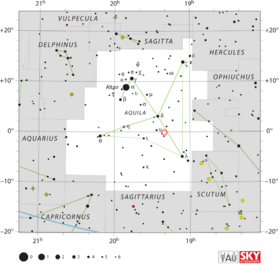Astronomy:V606 Aquilae
| Observation data Epoch J2000.0 Equinox (celestial coordinates) | |
|---|---|
| Constellation | Aquila |
| Right ascension | 19h 20m 24.3s[1] |
| Declination | −00° 08′ 07″[1] |
| Apparent magnitude (V) | 6.7p — 17.3p[1] |
| Characteristics | |
| Variable type | Classical nova, dwarf nova |
| Other designations | |
| Database references | |
| SIMBAD | data |

V606 Aquilae was a nova, which lit up in the constellation Aquila in 1899. The brightest reported magnitude for this nova was apparent magnitude 5.5, making it a naked eye object.[3][4] It was discovered by Williamina Fleming on a photographic plate (one of the Henry Draper Memorial Photographs[5]) taken on 21 April 1899 at the Harvard College Observatory. On the discovery plate, its photographic magnitude was later determined to be 6.75.[6] It was not seen on the plate taken on 1 November 1898,[3] and there were no reported observations of the region around the star during the 171 day interval before Fleming's discovery, so it is possible that the actual maximum of the event was missed. By 27 October 1899 it had faded to 10th magnitude, and on 9 July 1900 Oliver Wendell reported its brightness to be between magnitude 11.5 and 12.0.[7]
V606 Aquilae is classified as a "fast nova", because its faded by at least 3 magnitudes in about 65 days.[8] The light curve showed a steep decline, followed by a period of about 100 days when the light curve plateaued,[3] which caused its light curve to be classified as type P.[9][10]
The nova was "recovered" (meaning the quiescent nova was identified by modern observers) as a magnitude 20.4 object, in 2012 from photometric observations at the Very Large Telescope.[10] It is now a recurrent dwarf nova that flares every 270 days and with an amplitude of about 1.5 magnitude.[11]
References
- ↑ 1.0 1.1 1.2 Downes, Ronald; Webbink, Ronald F.; Shara, Michael M. (April 1997). "A Catalog and Atlas of Cataclysmic Variables-Second Edition". Publications of the Astronomical Society of the Pacific 109: 345. doi:10.1086/133900. Bibcode: 1997PASP..109..345D.
- ↑ Shapley, Harlow (January 1933). "The photographic light curves of 11 novae". Annals of the Astronomical Observatory of Harvard College 84 (5): 121–155. Bibcode: 1933AnHar..84..121S. https://ui.adsabs.harvard.edu/abs/1933AnHar..84..121S. Retrieved 23 January 2021.
- ↑ 3.0 3.1 3.2 Duerbeck, Hilmar W. (March 1987). "A Reference Catalogue and Atlas of Galactic Novae". Space Science Reviews 45 (1–2): 1–14. doi:10.1007/BF00187826. Bibcode: 1987SSRv...45....1D. https://ui.adsabs.harvard.edu/abs/1987SSRv...45....1D. Retrieved 21 December 2020.
- ↑ "The International Variable Star Index". AAVSO. https://www.aavso.org/vsx/index.php?view=detail.top&oid=1745.
- ↑ Barker, George F. (1887). "On the Henry Draper Memorial Photographs of Stellar Spectra". Proceedings of the American Philosophical Society 24 (125): 166–172. http://www.jstor.org/stable/983130. Retrieved 22 December 2020.
- ↑ Leavitt, H.S (1933). "Annals of Harvard College Observatory". Annals of Harvard College Observatory 84: 121.
- ↑ Pickering, E.C.; Fleming, W.P. (July 1900). "A new star in Aquila". The Astrophysical Journal 12 (290): 52. doi:10.1086/140728. PMID 17789894. Bibcode: 1900ApJ....12...52P.
- ↑ Duerbeck, H.W. (May 1988). "A Reference Catalogue of Galactic Novae". Bulletin d'Information du Centre de Donnees Stellaires 34: 127. Bibcode: 1988BICDS..34..127D. https://ui.adsabs.harvard.edu/abs/1988BICDS..34..127D. Retrieved 22 December 2020.
- ↑ Strope, Richard J.; Schaefer, Bradley E.; Henden, Arne A. (July 2010). "Catalog of 93 Nova Light Curves: Classification and Properties". The Astronomical Journal 140 (1): 34–62. doi:10.1088/0004-6256/140/1/34. Bibcode: 2010AJ....140...34S.
- ↑ 10.0 10.1 Tappert, C.; Barria, D.; Fuentes-Morales, I.; Vogt, N.; Ederoclite, A.; Schmidtobreick, L. (October 2016). "Life after eruption - VI. Recovery of the old novae EL Aql, V606 Aql, V908 Oph, V1149 Sgr, V1583 Sgr and V3964 Sgr". Monthly Notices of the Royal Astronomical Society 462 (2): 1371–1381. doi:10.1093/mnras/stw1748. Bibcode: 2016MNRAS.462.1371T.
- ↑ Kato, Taichi Kato; Kojiguchi, Naoto (2021). "V606 Aql (Nova Aquilae 1899) is now a dwarf nova". Variable Star Bulletin (Variable Star Observers League in Japan (VSOLJ)) (76). http://vsolj.cetus-net.org/vsoljno76.pdf.
 |


